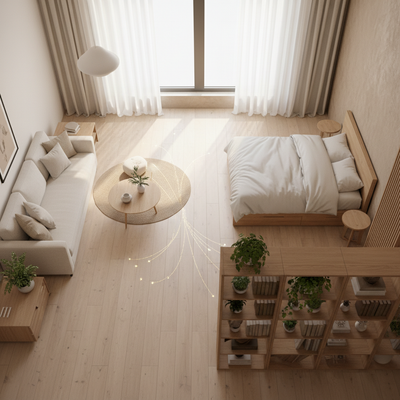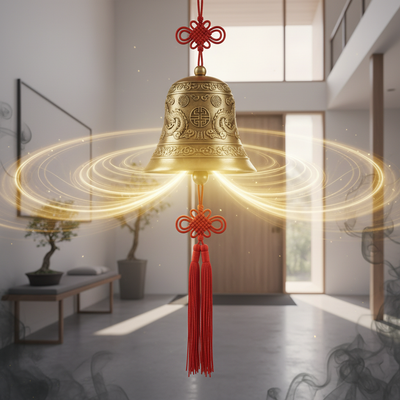Your Energy Foundation

In a world that constantly demands our attention, our bedroom should be the one place where we can fully recharge. It is more than just a room for sleep; it is your personal safe space, the energy foundation upon which your health, happiness, and success are built. Modern life is filled with stress, and a restful, refreshing space is no longer a luxury—it's absolutely necessary. But how do you transform a regular bedroom into a peaceful haven?
The answer lies in the ancient practice of Feng Shui. This is not a mystical art but a practical system of arranging your environment to support your well-being and life goals. At its core, Feng Shui is about mastering the flow of energy. The most powerful tool you have to create positive energy, or Qi, is the thoughtful placement of furniture and objects within your bedroom. This guide provides a complete blueprint, showing you exactly how to optimize your space for deep rest, peaceful relationships, and a profound sense of calm.
Understanding and Building Qi
To master bedroom Feng Shui, you must first understand its basic principle: Qi. This concept is central to creating a space that nurtures you on every level. By learning what Qi is and why it's so important in the bedroom, you move from simply following rules to naturally shaping an environment that supports your best life.
What is Qi?
Qi is the invisible life force energy that flows through everything in the universe, including your home and your body. Think of Qi like the water flowing through a river. When it moves freely, the water is clear, vibrant, and life-giving. In your home, this translates to feelings of energy, clarity, and opportunity. However, when the flow is blocked by clutter or poor layout, the water becomes still, murky, and slow-moving. This can show up as feelings of tiredness, confusion, and being "stuck" in life. The goal of Feng Shui placement is to ensure the Qi in your bedroom flows smoothly and gently.
Why Your Bedroom Matters
We spend about one-third of our lives sleeping. During this time, we are in a passive, receptive state, often called a "yin" state. Our energy defenses are down, making us highly sensitive to the quality of the environment around us. The energy of your bedroom directly affects your own personal energy field night after night. A bedroom with peaceful, positive energy placement supports your physical health, calms your mind, improves your relationships, and restores your spirit. On the other hand, a chaotic or poorly arranged bedroom can contribute to restless sleep, anxiety, health issues, and relationship problems. It is the most important room to get right.
The Commanding Position
If you make only one change to your bedroom, let it be this one. The single most important rule in bedroom Feng Shui is placing your bed in the Commanding Position. This isn't just about looks; it's about psychology and energy. This placement puts you in command of your room and, symbolically, in command of your life. It creates a subconscious feeling of safety and security, allowing you to fully relax and release the day's stress. From this position, you can see what is coming your way, both literally and symbolically.
Defining The Commanding Position
The Commanding Position is the location in a room that is furthest from the door and diagonal to it, but not directly in line with the door. When you are lying in bed, you should be able to see the entrance to the room without having to strain. This gives your nervous system the message that you are safe, aware, and in control. You are not surprised by anyone or anything entering your space.
Finding Your Command Position
Finding this important spot is a simple, step-by-step process. Follow these steps to identify the ideal placement for your bed.
- Stand in the doorway of your bedroom and look into the room.
- Identify the corner that is diagonally opposite from you. This is the primary power spot.
- The goal is to place your bed so that the headboard rests solidly against the wall in that corner.
- From this position, confirm that you have a clear, unblocked line of sight to the bedroom door. You should not be directly aligned with the door, but able to see it easily.
Solving Problem Layouts
Not all rooms have an obvious or "perfect" layout. Architectural features like windows, closets, or sloped ceilings can make achieving the ideal Commanding Position tricky. Here are expert solutions for common challenges:
- If you cannot avoid having your back to the door: This is the least desirable position, as it can create feelings of vulnerability. If this is your only option, the solution is to place a mirror in a location where it will reflect the doorway, allowing you to see it while in bed.
- If the only spot is in line with the door: This is known as the "coffin position" because energy rushes directly at you, which can be disruptive to sleep. If you cannot move the bed, place a piece of furniture like a sturdy bench or a small chest at the foot of the bed to act as a buffer.
- If you must place the bed under a window: A solid wall behind the headboard is always preferred for support. A window can feel less secure. The fix is to use a very strong, solid headboard and install heavy, supportive curtains that you close at night.
Placement Beyond the Bed
Once your bed is correctly positioned, the next step in creating positive energy placement is to arrange the other furniture in your Feng Shui bedroom. Each piece has its own energy weight and function. Proper placement ensures that every item contributes to an overall feeling of balance, support, and peace rather than creating subconscious stress.
Nightstand Placement
Nightstands are not just for holding a lamp and a book; they represent balance and support.
- Do: Use a matching pair of nightstands on either side of the bed. This creates symmetry and symbolizes equality and balance in a partnership. For single individuals, it energetically invites a balanced partnership.
- Do: Choose nightstands that are approximately the same height as the top of your mattress. Taller stands can feel overpowering, while lower ones can feel unsupportive.
- Don't: Allow them to become storage areas for clutter. Keep surfaces clear, holding only what is essential for a peaceful night, such as a lamp, a book, and a glass of water.
Placing Large Furniture
Large, heavy pieces like dressers, wardrobes, and armoires can feel overwhelming if placed incorrectly.
- Do: Place them against side walls, so they are not directly facing you while you sleep. The energy of a large object pointing at you can feel like a weight or pressure, disrupting rest.
- Don't: Position a tall armoire or dresser directly opposite the foot of the bed. If this is the only option, choose a piece with soft, rounded corners over one with sharp, angular lines.
Mirrors and Electronics
Mirrors and screens are considered energetically "active" (yang). They reflect light and movement, and in the case of TVs and phones, they emit an active energy that is counterproductive to the restful, "yin" energy a bedroom requires.
- A mirror facing the bed is said to disrupt sleep by bouncing energy around the room and can even be thought to invite a third party into a relationship.
- The best solution is to have no mirrors or TVs in the bedroom.
- If you must have them, place them inside a cabinet or armoire with doors that can be closed at night. A simple alternative is to cover the mirror or screen with a beautiful piece of cloth before you go to sleep.
Desks and Workout Gear
Your bedroom's primary function is rest and renewal. Introducing items related to work or intense exercise confuses the room's energy.
- We strongly advise against having a desk or exercise equipment in your bedroom. Your brain will associate the space with work stress or physical effort, making it difficult to switch off.
- If this is unavoidable due to space constraints, create a clear visual separation. Use a decorative folding screen, a curtain, or a bookshelf to partition the work/exercise area from your sleep space. At the end of the day, always clear your desk and put away workout gear to signal that the day is done.
| Item | Positive Placement (Do) | Placement to Avoid (Don't) |
|---|---|---|
| Nightstands | A matching pair, mattress-height, on either side of the bed. | Mismatched, cluttered, or significantly taller/shorter than the bed. |
| Dressers/Wardrobes | Against a side wall, not directly facing the bed. | Directly opposite the foot of the bed or looming over the headboard. |
| Mirrors | Inside a closet, or on a wall that doesn't reflect the bed. | Directly facing the bed. |
| TVs/Electronics | Removed from the room, or concealed inside a cabinet. | Opposite the bed, left uncovered at night. |

| Desks/Exercise Gear | In a separate room. If unavoidable, use a screen to separate it. | In a corner where it's the first/last thing you see, left messy. |
A QI FLOW Case Study
Theory is valuable, but seeing these principles transform a real space is what truly builds confidence. At THE QI FLOW team, we regularly witness the profound impact of positive energy placement. This case study of a recent client illustrates how strategic changes can shift a room from a source of stress to a sanctuary of healing.
The Client's Challenge
Our client, a marketing director we'll call Sarah, came to us feeling constantly exhausted. She reported high levels of anxiety, difficulty falling asleep, and a persistent feeling of being "on-edge" even at home. Her goal was simple: to get a good night's sleep and feel calm in her own space. Her bedroom, she admitted, felt chaotic and unwelcoming, but she didn't know where to start.
Our Feng Shui Solution
Our team conducted a consultation and immediately identified several key energy blockages. This was our first-hand analysis of her space:
- The bed was pushed against a side wall, directly in the path of the doorway. This is a classic "coffin position," where the Qi rushes towards the sleeper, creating a sense of instability.
- A large, mirrored sliding door on her closet directly faced the bed, amplifying active energy and reflecting her own image back at her all night, which is very unsettling for the subconscious.
- An overflowing work desk was crammed into the corner you see immediately upon entering, making "work" the dominant energy of the room.
- The space under her bed was filled with old boxes and storage, blocking the flow of Qi and creating stagnant energy right beneath her.
We implemented a precise placement strategy:
- We moved the bed into the Commanding Position. It was now against the solid wall diagonal to the door, giving her a secure view of the entrance.
- Since replacing the closet doors was not an option, we advised applying a beautiful, frosted decorative film to the mirrors. This obscured the reflection while still allowing the doors to function, instantly calming the room's energy.
- We sourced an elegant, lightweight folding screen to place around the desk. This created a visual and energetic boundary, effectively hiding "work" from the "rest" space.
- Finally, we guided Sarah through a decluttering process, starting with clearing everything from under the bed to allow energy to circulate freely as she slept.
The Sanctuary Result
The transformation was remarkable. Within two weeks, Sarah reported sleeping through the night for the first time in months. She described the feeling as "finally being able to breathe deeply in my own space." The anxiety that had plagued her evenings began to disappear. By changing the placement of her furniture, she had changed the entire energy dynamic of the room. Her bedroom was no longer a stressful extension of her office but had become her personal sanctuary for deep rest and positive energy.
Advanced Harmonizing Techniques
With your furniture in its optimal position, you can begin to fine-tune your bedroom's energy using more advanced Feng Shui concepts. These techniques go beyond placement to layer in nuance and harmony, personalizing the space to support you on an even deeper level.
Balancing The Five Elements
In Feng Shui, all of existence is made up of five elements: Wood, Fire, Earth, Metal, and Water. A balanced room contains a representation of all five. The bedroom, a space for stability and rest, should be grounded in the Earth element, with the other four used as accents.
| Element | Colors | Shapes | Materials & Decor |
|---|---|---|---|
| Earth | Yellow, Brown, Sandy, Beige | Square, Flat, Low | Ceramics, Pottery, Thick Rugs |
| Metal | White, Gray, Metallics | Round, Oval, Circular | Metal Frames, Metal Decor, White Linens |
| Water | Black, Darkest Blue | Wavy, Flowing, Asymmetrical | Images of calm water, Dark colors, Wavy patterns |
| Wood | Green, Teal, Blue | Rectangular, Columnar | Wood furniture, Plants (use sparingly), Floral prints |
| Fire | Red, Orange, Purple, Pink | Triangular, Pointed, Star | Candles (use with care), Red accents, Pointed objects |
Start by establishing a base of Earth tones (like a beige carpet or sandy-colored walls) for grounding. Then, layer in the other elements. A metal picture frame, a blue pillow (Water), a healthy plant (Wood), and a small pink candle (Fire) can complete the cycle and create a sense of wholeness.
The Power of Decluttering
This cannot be overstated: clutter is the number one enemy of good Feng Shui. It is the physical manifestation of stagnant, stuck Qi. It represents postponed decisions and creates a low-grade, constant drain on your energy.
The most critical area to address is the space under your bed. Storing items here, especially those with emotional baggage (like gifts from an ex-partner) or stimulating energy (like work documents), means you are literally sleeping on top of stagnant energy and unresolved issues all night. This practice is rooted in the classical Feng Shui principle of ensuring Qi can flow unobstructed around you as you rest, a cornerstone of the practice for centuries. Clear it out completely. Let the energy circulate freely.
Essential Finishing Touches
The final layers of a Feng Shui bedroom involve the sensory details that set the mood: color, lighting, and decor. These elements are the finishing touches that can elevate a well-placed room into a truly high-vibration sanctuary. They are often easy and inexpensive to implement, providing an immediate energy lift.
Choosing Soothing Colors
Color has a profound psychological and energy impact. For the bedroom, the goal is to create a calm, nurturing atmosphere.
- The best choices are "skin tones," which range from pale ivory and soft beige to rich chocolate browns. These colors are subconsciously associated with the human body, making us feel safe and nurtured.
- Earthy tones (sandy, taupe, soft gray) are grounding and stable.
- Soft pastels like dusty blue, pale green, or blush pink can also be very restful.
- Avoid large expanses of bright, stimulating colors like vibrant red or electric orange on the walls, as they are too active (yang) for a place of rest. Use them only as small, intentional accents.
Layering Bedroom Lighting
Harsh, single-source overhead lighting is jarring and unflattering. It creates a flat, institutional feel. Instead, opt for a layered lighting scheme to create a soft, adaptable ambiance.
- Start with a source of ambient light, such as a ceiling fixture on a dimmer switch.
- Add task lighting, like a pair of bedside lamps for reading.
- Consider a soft accent light, like a small salt lamp in a corner, which casts a warm, gentle glow.
- Using full-spectrum bulbs can help mimic natural daylight, which is beneficial for your circadian rhythm, especially if your room lacks natural light.
Selecting Meaningful Decor
Every object in your room should be something you love and that holds positive meaning. Your bedroom is not a museum for things you feel you should have.
- Choose artwork that evokes the feelings you want to cultivate. Peaceful landscapes, serene abstracts, or images of happy couples are excellent choices.
- Avoid artwork that is sad, lonely, aggressive, or chaotic. An image of a single, solitary figure may not be the best choice if you are seeking a partnership.
- Emphasize pairs. To enhance the energy of partnership and balance, use items in twos: two nightstands, two lamps, two matching pillows, two candles. This applies whether you are in a relationship or not, as it creates an energy of balanced wholeness.
Your Journey Starts Now
You now have the complete blueprint for positive energy placement feng shui bedroom. This guide has walked you through the foundational principles of Qi, the critical importance of the Commanding Position, and the nuanced details of arranging your entire space for harmony and rest. You have the knowledge to transform your room from a simple place to sleep into a powerful sanctuary that recharges your body, calms your mind, and supports your dreams.
Remember, this is a journey, not a destination. You don't have to do everything at once. Start with one small, powerful change and feel the shift it creates.
Your 3-Step Action Plan
- Assess Your Bed: Is your bed in the Commanding Position? Check tonight. If it's not, making this one move is the most powerful first step you can take.
- Declutter One Area: Don't get overwhelmed. Start small. Tonight, clear everything out from under your bed, or simply declutter and wipe down one nightstand.
- Cover the Screens: If you have a TV or a mirror facing your bed, cover it with a cloth tonight before you sleep. Notice if the air in the room feels calmer and if your sleep feels deeper.
By implementing these positive energy placement feng shui bedroom strategies, you are not just decorating a room; you are consciously designing a life filled with more rest, peace, and vitality. Your sanctuary awaits.







